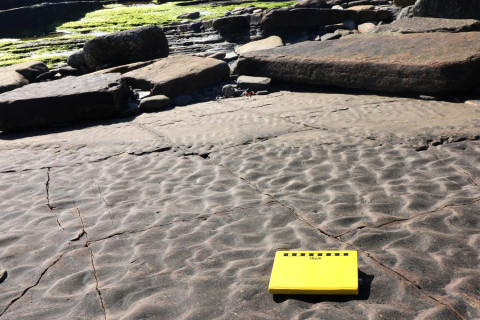EOSC 421 · Advanced Sedimentology

Description and interpretation of ancient and modern sediments, with emphasis on the origin, composition, textures, structures, diagenesis and chemistry of biogenic sediments. [2-2-0] Prerequisite: [EOSC320] or permission of instructor.
Syllabus
The fundamental aim of this course is to learn how to use sediments and sedimentary rocks as archives of information about sedimentary processes, ancient sedimentary environments, and sedimentary basins.
The objectives of the course are to:
- Describe and interpret sedimentary facies
- Quantify sediment transport and deposition processes using the sedimentary record
- Understand the journey of sediment from erosional sources to depositional sinks, and place sedimentary deposits into their broader contexts (with a particular focus on sediment-routing systems and sedimentary basins)
- Learn conceptual models of sedimentary systems, processes, and environments across different spatial and temporal scales
- Collect and interpret accurate sedimentological data
- Understand some of the current frontiers in sedimentological science
EOSC 421, Advanced Sedimentology, is organised into three parts:
Part 1: The world from a grain of sand
The first part of the course lays out the basics. What is sediment? Where does it come from, and how is it transported across the Earth's surface? When faced with sedimentary deposits in the field, what kinds of structures can we observe and -- more fundamentally -- what kinds of questions should we be asking?
Classes include:
- Sediment-routing systems
- Sediment sources
- Sediment fluxes
- Sedimentary structures
Part 2: Processes in sedimentary environments
Part two delves into the details about the processes that move sediment around, and the environments that they occur within and record information about. You will learn how signals of Earth's ancient environments, processes, and events have been transmitted into the sedimentary record, and how to read that record.
- Sediment gravity flows
- Subaqueous and subaerial unidirectional flows
- Subaqueous oscillatory current and rotating flows
- Carbonates and evaporites
- Volcanic sedimentology
- Planetary sedimentology
Part 3: The bigger picture
Finally, we will step back to ask (and answer) broader questions about sedimentology. What is the history of this exciting and cutting-edge science? How can we measure the ages of sediments and sedimentary rocks, and the rates at which sedimentary processes occur? How does sedimentology interface with plate tectonics and basin analysis?
- Dates and rates of sedimentary processes
- Formation and types of sedimentary basins
- Subsidence analysis
- Basins due to stretching, flexure, and strike-slip deformation
- Sediment provenance
- Diagenesis and alteration
Course Content
This course will be taught by Joel Saylor and Mitch D'Arcy.
EOSC 421: Advanced Sedimentology explores sedimentary rocks as archives of information about Earth's surface processes and geological history. We will explore how sediments and sedimentary rocks can be used to reconstruct surface processes, ancient sedimentary environments, and the evolution of sedimentary basins. The course will have a particular focus on describing and interpreting clastic sedimentary deposits from a modern process-based and sediment-routing systems perspective.
Pre-requisite: EOSC 320: Sedimentology, or the permission of the instructors.
Logistics:
Lectures: Wednesdays and Fridays @ 09:00-09:50
Labs: Thursdays @ 15:00-18:00.
Detailed information about the course materials is provided on the Canvas page.